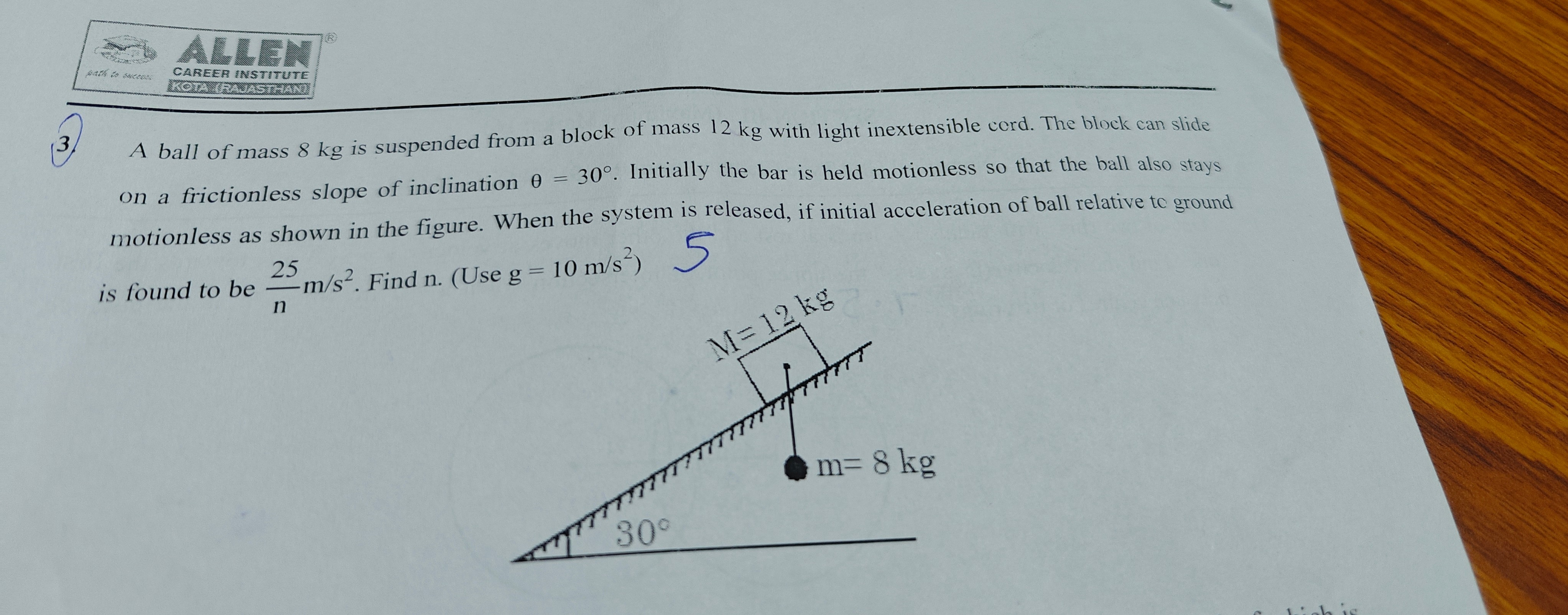Question
Question: A ball of mass 8 kg is suspended from a block of mass 12 kg with light inextensible cord. The block ...
A ball of mass 8 kg is suspended from a block of mass 12 kg with light inextensible cord. The block can slide on a frictionless slope of inclination θ=30°. Initially the bar is held motionless so that the ball also stays motionless as shown in the figure. When the system is released, if initial acceleration of ball relative to ground is found to be n25m/s2. Find n. (Use g = 10 m/s²)

12.5
Solution
The problem asks for the initial acceleration of the ball relative to the ground when the system is released. The system consists of a block of mass M=12 kg on a frictionless inclined plane of angle θ=30∘, and a ball of mass m=8 kg suspended from the block by a light inextensible cord. Initially, the system is motionless, meaning the cord is vertical relative to the ground. We are given g=10 m/s2.
Understanding "Initial Acceleration": At the instant the system is released (t=0+), the configuration is still as shown in the figure, with the cord being vertical. Since the cord is inextensible, if the cord remains vertical, the ball must have the same acceleration as the point of suspension on the block. This means the ball's acceleration relative to the ground (aball) will be the same as the block's acceleration relative to the ground (ablock). Both will be directed down the incline.
Free Body Diagrams and Equations of Motion:
-
For the Block (M): Let a be the acceleration of the block down the incline. The forces acting on the block are:
- Gravitational force: Mg vertically downwards.
- Normal force: N perpendicular to the incline, outwards.
- Tension from the cord: T vertically downwards (since the cord is vertical initially).
We resolve forces along and perpendicular to the incline.
- Component of Mg along the incline: Mgsinθ (down the incline).
- Component of Mg perpendicular to the incline: Mgcosθ (into the incline).
- Component of T along the incline: Tsinθ (up the incline).
- Component of T perpendicular to the incline: Tcosθ (into the incline).
Applying Newton's second law along the incline: Ma=Mgsinθ−Tsinθ(Equation 1)
-
For the Ball (m): Let aball be the acceleration of the ball relative to the ground. As discussed, at the initial instant, aball=a (directed down the incline). The forces acting on the ball are:
- Gravitational force: mg vertically downwards.
- Tension from the cord: T vertically upwards.
Applying Newton's second law in the vertical direction: The vertical component of the ball's acceleration is asinθ (downwards). m(asinθ)=mg−T(Equation 2)
Solving the Equations:
From Equation 2, we can express tension T: T=mg−masinθ
Substitute this expression for T into Equation 1: Ma=Mgsinθ−(mg−masinθ)sinθ Ma=Mgsinθ−mgsinθ+masin2θ Rearrange the terms to solve for a: Ma−masin2θ=(M−m)gsinθ a(M−msin2θ)=(M−m)gsinθ a=M−msin2θ(M−m)gsinθ
Substitute the given values: M=12 kg m=8 kg θ=30∘⟹sinθ=1/2 g=10 m/s2
a=12−8×(1/2)2(12−8)×10×(1/2) a=12−8×(1/4)4×10×(1/2) a=12−220 a=1020 a=2 m/s2
The initial acceleration of the ball relative to the ground is a=2 m/s2. The problem states that this acceleration is n25 m/s2. So, n25=2 n=225 n=12.5
The final answer is 12.5.
